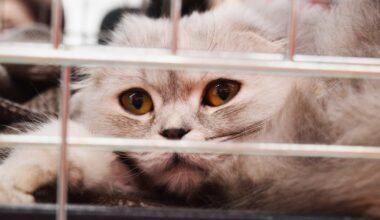The Impact of Environmental Changes on Cat Anxiety
Environmental changes can significantly affect the well-being of our feline friends, leading to various levels of anxiety. Cats are creatures of habit, and disruptions to their routine or habitat can induce stress and anxiety. Changes can be due to moving to a new home, the arrival of new pets, or even renovations within the same living space. Understanding the effects of these changes is crucial for maintaining your cat’s mental health. When cats feel unsafe or insecure, their anxiety levels can rise, resulting in behavioral issues such as hiding, aggression, or excessive vocalization. It is essential to observe any alterations in your cat’s behavior in response to changes in their environment. You might notice that your cat becomes more withdrawn or begins to over-groom due to stress. Providing a safe space and maintaining routine can alleviate some anxiety. This may include providing cozy hiding spots where your cat feels protected and secure. Many owners may not realize that even slight alterations in their surroundings can profoundly affect their pets’ emotional state. Identifying these triggers is the first step toward a more harmonious environment.
One common aspect of environmental changes that can contribute to cat anxiety is noise. Loud sounds such as construction, fireworks, or even sudden thunderstorms can make cats feel threatened. Cats possess keen hearing abilities, which means noises that seem minor to us can be overwhelming for them. In these cases, recognizing how noise pollution affects your cat is vital. Strategies can be implemented to minimize these discomforting noises. This may involve creating a quiet area in your home where your cat can retreat when external sounds become too intense. Often, playing soothing music or using white noise machines can help mask sudden, jarring sounds. Additionally, helping your cat associate these noises with positive experiences can reduce anxiety over time. When your home is filled with unexpected sounds, ensuring your cat feels safe and secure is your responsibility. Keeping your kitty indoors and away from noise sources can drastically improve their sense of safety. Strategies like these are essential in fostering a peaceful environment for our beloved pets, ensuring their mental health is prioritized amid environmental challenges.
Understanding the Role of Space in Cat Anxiety
The physical space available to a cat can also influence their mental health. Cats typically require personal space to explore or retreat when they feel vulnerable. In congested homes where space is limited, or multiple pets compete for attention and territory, anxiety may increase. Recognizing the importance of space helps create an enriching environment for your cat. Offering platforms, such as cat trees and shelves for climbing, cultivates a sense of security. These structures allow cats to observe their surroundings from a safe height, reducing their stress levels. Providing several cozy, designated areas throughout your home fosters a sense of security and safety for your feline friend. Each cat may have specific preferences regarding their environments, so observing their natural tendencies can aid in determining optimal configurations. Offering various enrichment activities, like toys and scratching posts, can also help to alleviate anxiety. Spaces designed for exploration enhance their daily experiences, letting them engage in natural behaviors, which can lead to a more confident and stress-free cat environment. The interplay between space and a cat’s comfort cannot be overstated.
Furthermore, any significant change in living conditions brings about stressors we might overlook. For example, adopting a new pet can lead to rivalry or territorial disputes, contributing to anxiety among existing pets. Introducing pets should be done gradually to allow all animals to adjust properly. While pets may adjust to each other, some might take longer to acclimate than others. By maintaining calm environments during introductions, the stress levels of all pets can be monitored. Likewise, if you’re anticipating guests or change in household dynamics, consider gradually introducing new scents or sounds associated with the changes beforehand. This helps your cat prepare emotionally before the actual change occurs. Temporary separation of pets during stressful events may be necessary to keep everyone comfortable and secure. Building a sense of community in the household provides a more balanced emotional environment for all pets involved. Communication and observance of behavioral shifts can offer insights into your pets’ emotional states during these transitions, ultimately promoting their well-being. Ensuring your cat experiences minimal disturbance during life changes is essential.
The Importance of Routine for Cat Anxiety Management
Routine plays a critical role in helping manage cat anxiety. Cats thrive on predictable schedules because they rely on their daily rhythms for stability. Any deviations from their established routine can trigger anxiety, so maintaining consistency is vital. This includes feeding times, play sessions, and even grooming rituals, which should occur at the same time daily whenever possible. Reinforcing these routines ensures your feline friend feels secure and familiar with their environment. One advantageous way of preserving balls of daily activities while reducing anxiety is through scheduled playtime. Regularly engaging with your cat during peak activity hours fosters security, reinforcing your bond and helping alleviate possible triggers. Additionally, incorporating ambient environments like soft music can create a calming atmosphere during stressful events. Furthermore, maintaining consistency becomes fundamental when easing anxiety in multi-pet households. Ensure that every cat has specific routines that are respected to minimize overlap and competition. The benefits of a routine extend not only to reducing anxiety but also promote a more harmonious household, reducing stress for both people and pets alike. Cats show improved mental states when stability is prioritized.
Another environmental factor affecting cat anxiety is litter box cleanliness, which can facilitate stress-related behavior. Cats instinctively avoid using dirty litter boxes, which may lead them to find alternative spots, causing frustration for both the cat and owner. Regularly cleaning the litter box is crucial for your cat’s mental well-being. If you notice aversion or avoidance behavior toward using the litter box, reassess its cleanliness and location. Ideally, each cat should have a designated litter box, plus one extra, to ensure comfort and reduce territorial disputes. This method allows each cat to have their own space during moments of stress. Different types of litter can also affect a cat’s willingness to use the box. Experimenting with various options may help identify your cat’s preferences. Ensuring your cat has easy access to their bathroom is vital, considering how certain environmental changes—like the addition of new furniture—may obstruct their paths. When the living space feels overwhelming, stress often increases, thus emphasizing the importance of maintaining a clean and accessible litter box for reducing anxiety.
Environmental Enrichment for Anxious Cats
Creating an enriching environment is another significant way to alleviate anxiety-related behaviors in cats. Environmental enrichment focuses on providing a stimulating atmosphere that encourages various forms of play and interaction. Interaction with toys, climbing structures, and scratching posts makes for an engaging day, helping cats express natural behaviors while expending energy. It’s paramount to recognize that boredom can significantly heighten anxiety levels. Regularly rotating toys and climbing structures can keep your cat mentally stimulated and prevent them from developing problematic behaviors stemming from anxiety or boredom. Furthermore, exposing your cat to various scents can stimulate their interest and curiosity. Introducing new smells can pique their interest, enticing their natural instincts to explore their surroundings. Creating a multi-sensory environment not only reduces stress but promotes healthier habits. Incorporating puzzle feeders can also keep your cat’s mind active and give them an outlet for natural hunting instincts. When cats experience a well-rounded and stimulating environment, their anxiety levels significantly decrease, leading to a happier and healthier lifestyle. Aim to provide a range of options that caters to your cat’s unique personality and preferences.
To summarize, various environmental changes can profoundly influence cat anxiety, making it essential to understand the symptoms and triggers involved. Noise, physical space, routine, and cleanliness all contribute to your cat’s mental well-being. Recognizing these components allows you to create a safe and secure environment for your feline companion. Implementing strategies to mitigate anxiety-producing factors creates a balance that enhances your cat’s quality of life. Engaging in environmental enrichment by incorporating toys and structures promotes exploration and playfulness while preventing boredom-induced anxiety. Remember that the key to managing anxiety in cats often starts with observation and understanding their unique personalities. Just as humans cope with stress in different ways, cats also have their own preferences for comfort. Achieving a calm atmosphere requires several strategies, focusing on consistency while observing behavioral changes within your pet. Keeping this in mind cultivates an enriching environment that promotes mental well-being and happiness for your feline friend. As pet owners, being proactive in understanding our beloved cats’ emotional needs leads to better relationships and healthier lives.


